

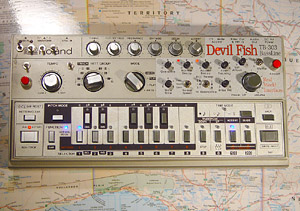 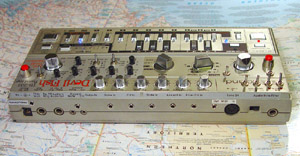 |
This Devil Fish from
late 2014 has: the 32 Bank Memory System, with Dynamic Bank Switching;
the MIDI In and Out system with Dynamic Channel Switching; a
centre-off, spring-return from the bottom, switch to enable the Audio
In to Filter signal (previously the Mix In socket) and the separate
3.5mm headphone out socket. In the past, someone supplied this machine with far more than 9 volts, causing the regulator transistor to overheat and so to the deformation of the top part of the case near the power socket. Please see the main Devil Fish page for notes on choosing a suitable power adaptor. [#labels]The
small labels
on the back panel, and the serial number label on the bottom of the
machine (picture) are
made with a technique we developed:
Inkjet printing (we use an Epson Stylus Pro 3800, with Ultrachrome K3 pigment inks) onto a unique self-adhesive satin-metallic label material: A-One 29283. This is only available in Japan. We import it via fromjapan.co.jp . The ink must be thoroughly dried, such as by placing the entire printed label in an electric frying pan at 110 to 130C for 20 minutes. Then we laminate the entire label, cut it to size, and trim its corners with this corner cutter: CR2MM . A full description of the technique is at: http://www.firstpr.com.au/rwi/tr-808/TR-808-switches/#labelprinting |
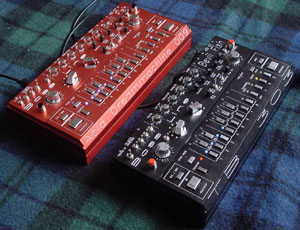 |
Here are two AluCase Devil
Fishes from 2001. The AluCases – for Devil Fishes and TB-303s – are custom-made by Martin
Rothlisberger in Switzerland. Please see his site: acid.ch . There are some moderate extra costs in me fitting a Devil Fish in an AluCase. Please contact me for details. One arrangement is for the customer to send their TB-303 to me and for Martin to send one or more AluCases, for this and potentially other Devil Fishes, in a separate shipment. Alternatively, the customer can take delivery of the AluCase from Martin, and then ship it and the TB-303 to me. It is not practical for anyone but me to fit a Devil Fish into an AluCase. |
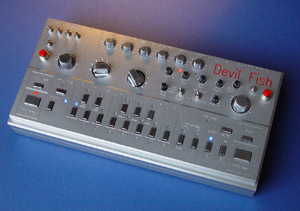 |
This is an AluCase
from 2009. AluCases will last forever. They are NC machined from solid blocks of aluminium. Then they are sandblasted, anodized and generally dyed. Some are undyed as is this one, with a bright metallic aluminium surface, protected by the aluminium oxide layer created by the anodizing process. Aluminium oxide is a ceramic and is used in grinding stones and the ceramic packages of integrated circuits. The dye soaks into the somewhat porous aluminium oxide layer, and then with heat treatment, this is made very hard indeed. This one only has coloured lettering for the Devil Fish logo. The two above have epoxy paint carefully applied for all lettering and lines. |
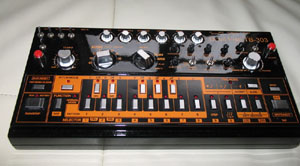 |
Jeff Toman in the UK www.customsynth.co.uk
worked
on this Devil Fish after I modified it. There are many photos of
Jeff's work on his Flickr
pages. Perhaps the best way to navigate those photos is the sets section. I understand the aluminium panel is original, but stripped back to the bare metal and then screen printed and that the rest of the front panel is screen printed too. |
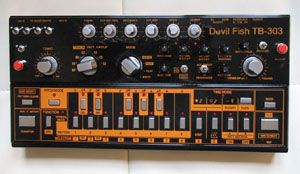 |
I haven't seen this machine
after its case was refurbished. I understand that the rear panel
sockets are labeled with a back-printed clear film, but this is not
visible in the photos below. The photos were somewhat distorted and blurry. I used the excellent PTLens Photoshop plug-in to correct the barrel (or pincushion) distortion which often occurs with the wide-range zoom lenses used in digital cameras. Then I sharpened the image with Photoshop's Unsharp Mask. |
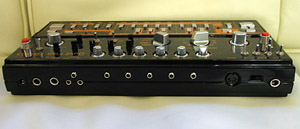 |
|
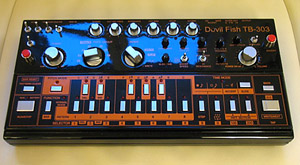 |
|
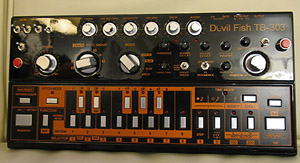 |
|
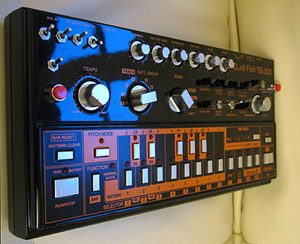 |
|
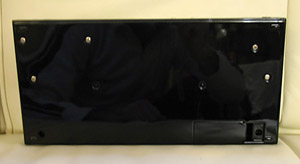 |
|
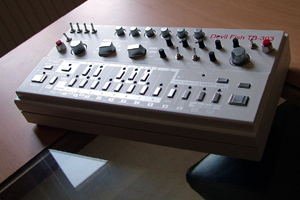 |
This Devil Fish has
an AluCase which has been sprayed by Jeff Toman in the UK.
AluCases are not intended to be sprayed – they are anodized
and the
alumina anodized layer is typically dyed. The lettering is
engraved into the aluminium, and Martin typically paints these with
epoxy paint. |
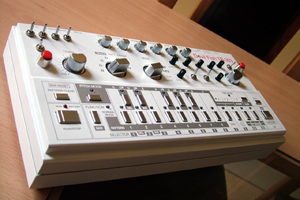 |
I haven't seen
this machine – Jeff sent me the
photos of this and the black machine
above. I understand that for this one, he filled in the engraved
lettering and sanded the AluCase to provide a smooth surface which the
paint would adhere to. Then he screen printed new text and other
legends, in silver. |
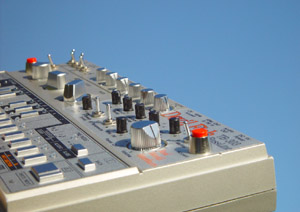 |
Some views of a Devil Fish with
an original plastic (ABS) case. |
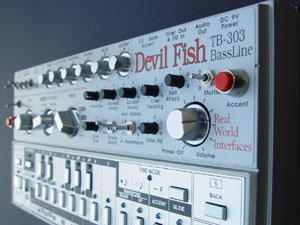 |
|
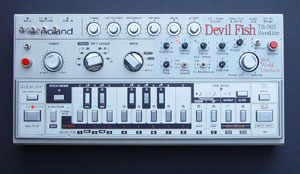 |
|
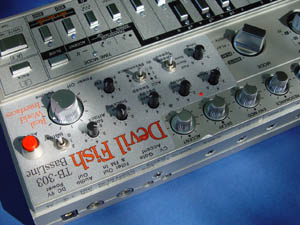 |
|
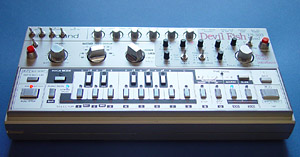 |
|
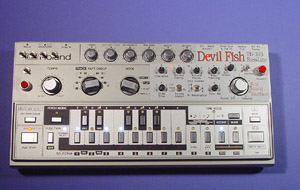 |
[#White_LEDs] This machine, in
September 2010, has White
LEDs with a new Red LED for Run/Stop.
This photo was taken in relatively dim incandescent light – 75 and 53 watt lamps at 0.8 metres –
so the LEDs look very bright. Their actual brightness is well
above the dim and uneven level of the original LEDs, but i not
excessive. More information on LEDs is at: ../leds/ . |
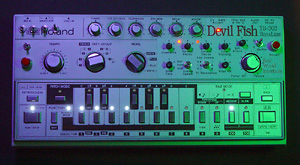 |
Another machine, with
a White
LED for Run/Stop. |
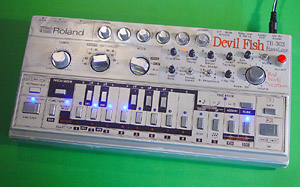 |
[#Worn_case] Some
Devil Fishes
wouldn't win a beauty contest, but they work just fine. This
machine has blue LEDs which were part of a Technology Transplant
replacement switch board. I changed some resistor values to bring
the brightness down to acceptable levels, since these LEDs, like most
blue LEDs, are much more efficient than the original early 1980s red
LEDs. |